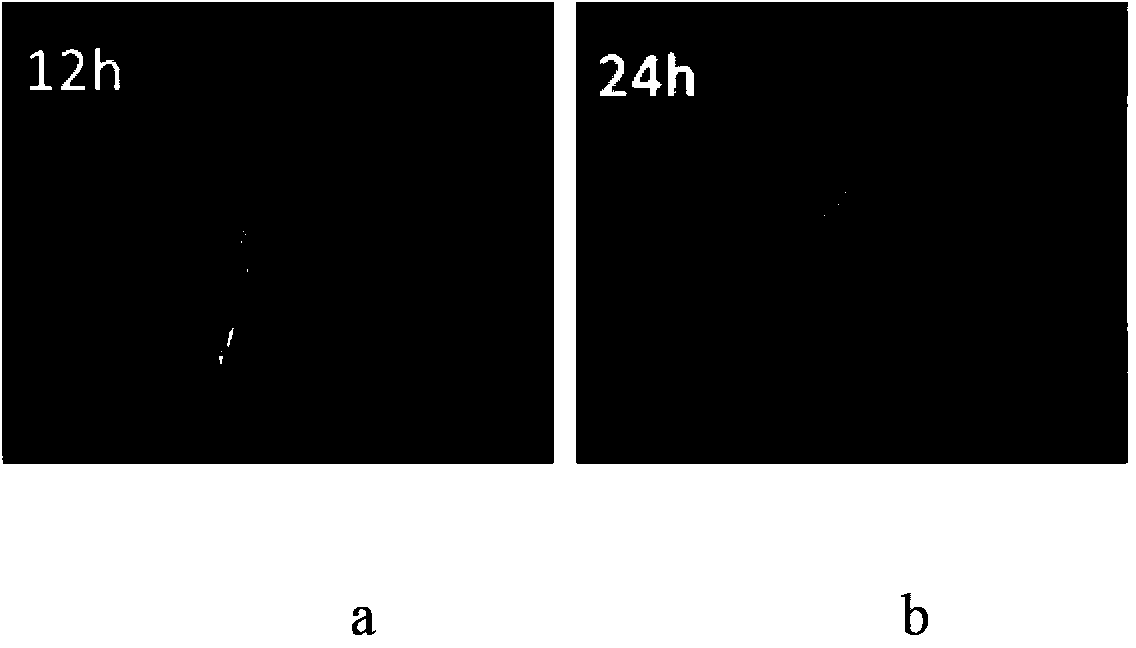Visible tracking and detecting method for protease in leather treatment process
A technology for leather processing and tracking detection, applied in measuring devices, instruments, scientific instruments, etc., can solve problems such as difficulty in detecting permeability
- Summary
- Abstract
- Description
- Claims
- Application Information
AI Technical Summary
Problems solved by technology
Method used
Image
Examples
Embodiment 1
[0024] 1) Prepare 2 mg / mL Genecor TanG protease solution and 1 mg / mL FITC solution with phosphate buffer solution with a pH value of 8.0 as solvent;
[0025] 2) Slowly add 0.2mL of FITC solution to 10mL of Genecor TanG protease solution and shake well, so that the mass ratio of Genecor TanG protease to FITC in the resulting reaction system is 100:1, and then react at 4°C in the dark for 10h , to obtain the reaction solution;
[0026] 3) Put the reaction solution into a dialysis bag with a molecular cut-off range smaller than the molecular weight of Genecor TanG protease, and then put it into a phosphate buffer with a pH value of 8.0 for oscillating dialysis. During the oscillating dialysis process, change the pH value once every 2 hours. 8.0 phosphate buffer solution until the eluate obtained by dialysis has an absorbance of 0 at 480nm, indicating that there is no free FITC in the eluate obtained by dialysis, and the dialysis is stopped. At this time, the remainder in the dial...
Embodiment 2
[0029] 1) Prepare 2 mg / mL Genecor TanG protease solution and 1 mg / mL FITC solution with phosphate buffer solution with a pH value of 8.0 as solvent;
[0030] 2) Slowly add 0.2mL of FITC solution to 10mL of Genecor TanG protease solution and shake well, so that the mass ratio of Genecor TanG protease to FITC in the resulting reaction system is 100:1, and then react at 4°C in the dark for 10h , to obtain the reaction solution;
[0031] 3) Put the reaction solution into a dialysis bag with a molecular cut-off range smaller than the molecular weight of Genecor TanG protease, and then put it into a phosphate buffer with a pH value of 8.0 for oscillating dialysis. During the oscillating dialysis process, change the pH value once every 2 hours. 8.0 phosphate buffer solution until the eluate obtained by dialysis has an absorbance of 0 at 480nm, indicating that there is no free FITC in the eluate obtained by dialysis, and the dialysis is stopped. At this time, the remainder in the dial...
Embodiment 3
[0035] 1) Prepare 2 mg / mL Genecor LimeG protease solution and 1 mg / mL FITC solution with glycine-sodium hydroxide buffer solution with a pH value of 9.0 as solvent;
[0036] 2) Slowly add 0.5mL of FITC solution to 10mL of Genecor LimeG protease solution and shake well, so that the mass ratio of Genecor LimeG protease to FITC in the resulting reaction system is 100:2.5, and then react at 4°C in the dark for 10h , to obtain the reaction solution;
[0037] 3) Put the reaction solution into a dialysis bag with a molecular cut-off range smaller than the molecular weight of Genecor LimeG protease, and then put it into a glycine-sodium hydroxide buffer solution with a pH value of 9.0 for oscillating dialysis. During the oscillating dialysis process, change 1 Glycine-sodium hydroxide buffer solution with a secondary pH value of 9.0, until the eluate obtained by dialysis has an absorbance of 0 at 480nm, indicating that there is no free FITC in the eluate obtained by dialysis, stop dial...
PUM
 Login to View More
Login to View More Abstract
Description
Claims
Application Information
 Login to View More
Login to View More - R&D
- Intellectual Property
- Life Sciences
- Materials
- Tech Scout
- Unparalleled Data Quality
- Higher Quality Content
- 60% Fewer Hallucinations
Browse by: Latest US Patents, China's latest patents, Technical Efficacy Thesaurus, Application Domain, Technology Topic, Popular Technical Reports.
© 2025 PatSnap. All rights reserved.Legal|Privacy policy|Modern Slavery Act Transparency Statement|Sitemap|About US| Contact US: help@patsnap.com

